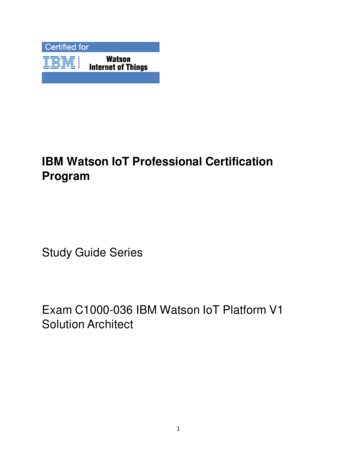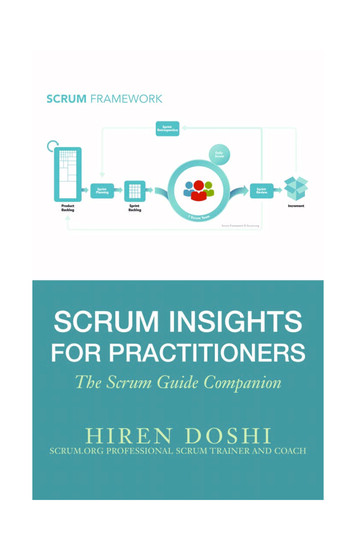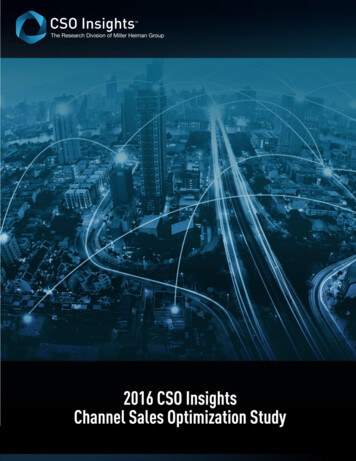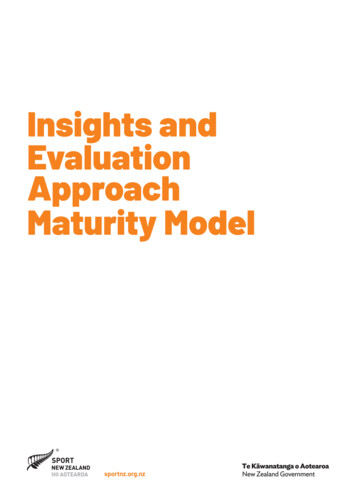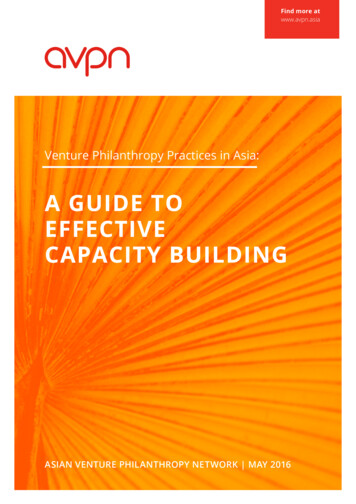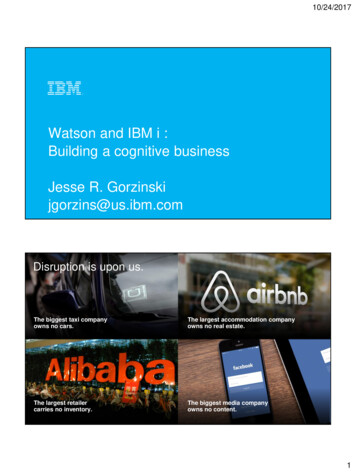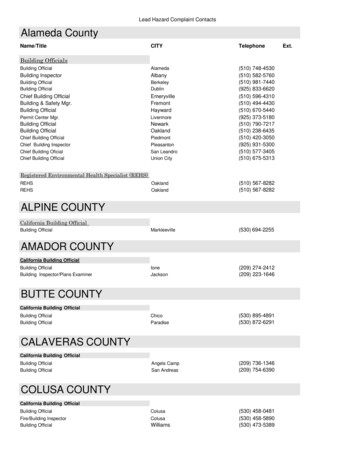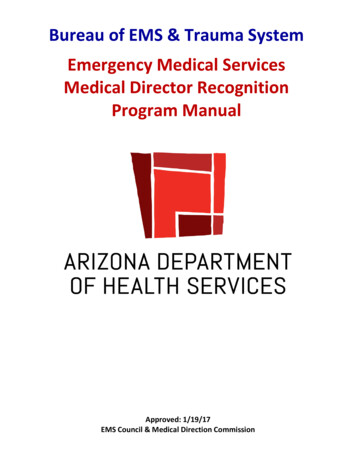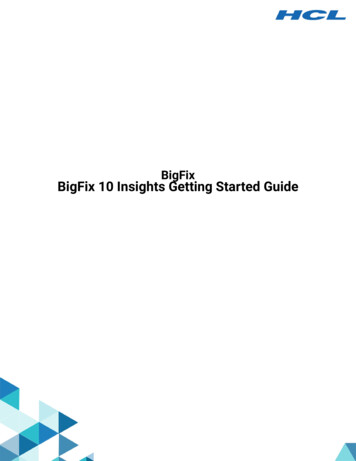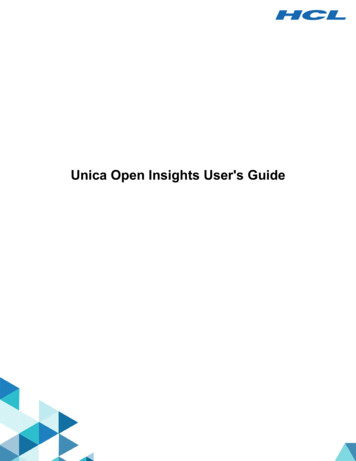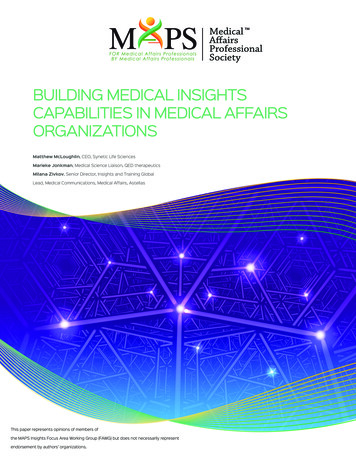
Transcription
BUILDING MEDICAL INSIGHTSCAPABILITIES IN MEDICAL AFFAIRSORGANIZATIONSMatthew McLoughlin, CEO, Synetic Life SciencesMarieke Jonkman, Medical Science Liaison, QED therapeuticsMilana Zivkov, Senior Director, Insights and Training GlobalLead, Medical Communications, Medical Affairs, AstellasThis paper represents opinions of members ofthe MAPS Insights Focus Area Working Group (FAWG) but does not necessarily representendorsement by authors’ organizations.1
INTRODUCTIONPharmaceutical companies continue to evolve the way they operate, both internally and within theexternal environment. A variety of factors drive this evolution including societal expectations, continuedchanges in healthcare systems across geographies, advances in digital technology and its application(as highlighted during COVID 19), and complex legal, regulatory, compliance, and privacy obligations. As aresult of these factors, the Medical Affairs (MA) function will become increasingly critical due to its uniquepositioning, as follows:Externally, MA engages with stakeholders in a non-promotional/ scientific manner to understandthe patient journey from the perspective of all key stakeholders including patients, HCPs, andpayersInternally, MA interacts with cross-functional and cross-divisional stakeholders throughout thevalue chainMA can also act as a mediator between the internal and external environments, driving strategy andinnovation through scientific and patient-centred medical insights.This paper explores the MA-based medical insights function and insights-related activities from an MAoperational perspective, and identifies basic operational elements required to establish medical insightsas a core strategic MA function.“Medical Affairs stands to be one of the most strategically important and valuedfunctions in a pharmaceutical company, as the nexus of cutting-edge medical,scientific and patient-centred insights that drive strategy and innovation throughoutthe entire product life cycle” 112McLoughlin and Croft (2018), Medical Affairs 2025, The future of Medical Affairs, Kinapse 2018
Medical insights are a cornerstone of theMedical Affairs value propositionMedical insights from the external environment have always been important to the pharmaceuticalindustry, but the nature and sources of insights have evolved. HCP opinion was traditionally gathered ina targeted way through advisory boards and individual consultations. While this approach continues togenerate key medical insights, there is now recognition of the opportunity to develop earlier and morecomprehensive understanding of external stakeholder needs (particularly patients and caregivers). Thisrequires MA organizations to expand their approach, combining the following:Multiple channels to gather information from the external environment e.g., patient ad boards,social media listening, publications etc.Technology to collate, curate, analyse and interpret information gatheredOperational structure to share and utilise that information, identify medical insights andmanage the overall insights process“An insight is new information, understanding, ideas or perspectiveson topics relevant to a company that may identify a gap, and/or informstrategy, and/or confirm pre-existing views held by the company andmay result in an action where and when appropriate.”— MAPS Insights GlossaryThe Insights FAWG Medical Insights surveysGiven the increasing focus on medical insights, the MAPS FAWG conducted two surveys of MAPSmembership in early 2020. The surveys highlighted the following key points:There was wide variation in how companies approach medical insights, with no apparent areasof best practice or common frameworks in use.Approximately half of the respondents have an MA function defined as responsible for medicalinsights; however, standalone Medical Insights functions are relatively infrequent and exist inless than a third of respondents’ organizations.3
For many companies, Field Medical-driven activities appear to be the focus of insight generation,with limited use of some other channels (e.g., only 26% of respondents systematically collectinsights from scientific literature, and only a quarter collect insights from social media sources).There appear to be challenges in creating a closer link and feedback loop between thoseworking at the customer interface and those setting strategy, including identification of ‘realinsights’ and linking them to action.There appears to be consensus across the industry on the relevance of medical insights asa principal driver for strategy determination and choice of tactics. However, the survey resultssuggest that the everyday practice of medical insight generation is fragmented - in 47% ofrespondents’ organizations (Survey 2), insights generated across different sources are notintegrated.Although there is often consensus on the importance of medical insights, the remit of an MA function inmedical insights varies. Some organizations regard MA insights as an add-on to competitive intelligenceand market research exercises led by Commercial. Where more mature capabilities are available,companies seek MA input on cross-functional compound/product strategy development from credibleand comprehensive medical insights based on patient, HCP and payer needs and value drivers.What can MA organizations do to optimizemedical insights-related activities?As confirmed by the MAPS Insights FAWG surveys, there is wide variation across the industry in howcompanies approach the generation, curation, reporting, sharing and utilization of MA insights. Too often,digital technology focused on the Field Medical function is the first reference point when companiesattempt to develop in this area. In this paper, we propose a more holistic approach to the MA operatingmodel for driving medical insights activities, recognizing interdependencies between the components.Figure 1. proposes a holistic framework through which to consider design of an MA operating modelfor insight-related activities, with foundational elements we believe are critical to success. Each of thefoundational elements will subsequently be discussed in more detail.4
How do we generate, share and utilize actionable medical insights?MA insights strategyDefinitions and ObjectivesOperating ModelThe process,inputs andoutputsSystems nance,complianceand privacyFigure 1. Proposal for a holistic operating model for medical insights related activities in a MA organizationDefinitions and objectives aligned with MAinsights strategyAs with the design of any operating model, the first challenge is to align on and communicate what weare trying to achieve. While the aspiration may be to have Medical Affairs lead the integration and analysisof ‘Patient’ insights from all channels, this can be complicated in large companies. We have identified thefollowing three key factors at this stage:A clear definition of medical insights that delineates the remit of the MA organization fromcompetitive intelligence or commercial insights and helps to clarify the role of medical insightsin better understanding of the needs of patients and other stakeholders in the healthcareecosystem.Internal clarity on medical insights as a core MA activity performed to drive strategic and tacticalchoices which helps to determine the approach to building medical insights infrastructure.Understanding of how insights are regularly reviewed and utilized to adapt tactics throughoutthe year, as opposed to generating insights and reports without a clear idea of how and whento use them.5
For the purpose of this paper, we will focus on medical insights as defined in the MAPS Insights Glossary,i.e., as new information, understanding, ideas or perspectives received from external sources throughMA-led activities, and pertaining to medical topics relevant to the company, including but not limited tothe general healthcare environment, diagnosis and unmet medical needs, treatment patterns, patientjourney and specific regional or local issues.The process, inputs, and outputsDefining and documenting the processThe core elements of the medical insights process are shown in Figure 2. The process will naturally varyin complexity depending on factors such as company size, disease area breadth, product life cycle stage,portfolio, and integration of geographies and functions into the MA organization. Ultimately, process designwill depend on how insights are used. Medical insights could be reviewed and combined with insights fromepidemiology, safety, clinical and commercial at a country or regional level, or this could happen at a globalbrand or therapy area level, depending on the needs and structure of the organization. The optimalapproach for a given company will depend on how the insights inform action and strategy and will alsoreflect organizational structure. Irrespective of the factors described above, the steps in Figure 2 serve asa basis for establishing a medical insights process in any MA organization.Source andcollectionchannelsLinking insightto actionReviews andanalysisINSIGHTSReporting andsharingIntegrationFigure 2. Medical insightsprocess and related activitiesDocumentationand storage6
Sources of insight and inputs to the processThe surveys highlighted that many MA organizations consider insights to be limited to those that FieldMedical/MSLs gather from external scientific and clinical expert interactions. This perspective unnecessarilylimits the scope and value of what is possible for an MA organization. While some sources of informationand insights are more accessible than others, organizations should consider all external interactions(through digital portals, virtual or in-person meetings) across all MA functions as potential insight gatheringopportunities. This includes, but is not limited to, interactions between MA and HEOR representativesand external stakeholders, Medical Information, Advisory Boards, consultations, or Medical Education. Inaddition, technology that enables automated searching and analysis of structured and unstructured,quantitative, and qualitative, data is much more widely available and tailored to the life sciences industrythan it was several years ago. Technological evolution now enables social media listening, as well assimilar analyses of external publications, internal data sources, Adverse Event reports and other databases containing unstructured qualitative data.Given the vast array of data sources available, the framework defining which sources should be routinelyanalysed within an MA organization becomes key. Ultimately, this framework should be organised bystrategic pillars or themes that are relevant to the users of insights, rather than by insight source. A fitfor-purpose operational framework will aid the integration of data and information, particularly in large andcomplex organizations that use a multi-channel approach to insight generation.Outputs and recipients of insightsDrawing on feedback from the survey, one of the most important aspects is to define what purpose medicalinsights serve and for whom. This enables the MA organization to create a feedback loop between thoseworking at the external stakeholder interface and those setting strategy, helping to generate actionableinsights and ensure streamlined insights-related activities.Determining which stakeholders are primary insights recipients versus secondary recipients is essentialto determining the nature of the output, its format and frequency, and any associated commentary.Figure 3 outlines considerations for optimizing medical insights reports based on feedback from insightsrecipients. Primary internal recipients will vary between organizations, but in most cases will include MA,HEOR, Product, Region and/or Affiliate leaders, as well as therapy area leads. Other MA leaders, such asexternal stakeholder engagement, field medical, scientific communications or knowledge training leads, arealso becoming primary internal stakeholders due to MA organizational diversification and specialisation. Incontrast, leaders outside of MA may be primary or secondary recipients.7
How are insights used in MAplanning?What would insights recipientsrefine or change about insightcollection or presentation?Which other cross-functionalmembers derive value frominsights?What actions are being takenas a result of insights?What well are outputs meetings theneeds of insights recipients?Figure 3. Considerations for optimizing medical insights reportsSystems and storageAlmost half (47%) of survey respondents reported the use of CRM systems to store medical insightsat their organizations. However, CRM systems tend to be oriented towards the external stakeholderswith which an MA organization interacts. This is useful for field medical colleagues in terms of insightcollection and use of insights to inform future interactions. However, a more fit-for-purpose data repositoryor platform is required if insights are to be used as a resource to drive strategy and action in broaderinternal stakeholder groups. Such a platform must support the stages of the medical insights process inFigure 2., and should ideally enable the following:Upload of information from different medical insights-generating functions and sources, fromboth validated internal systems (e.g., CRMs and MI systems) that collect structured informationand data, as well from other internal tools used to collect and store non-structured informationand data (e.g., narratives or slide decks stored on SharePoint or other internal repositories)Automated curation of insights, and their categorisation around dimensions that are relevantto the MA organization and medical insights usersAutomated creation and delivery of reports and metrics relevant to the organization, linkingto the already established metrics, analytics or reporting tools used in the organization (e.g.,Tableau)Availability of a user-friendly interface that facilitates information or pre-insights submission and providesguidance on insights the MA organization is looking for can also be helpful.8
CapabilitiesCapabilities should be considered both in terms of organizational capability as well as individualcompetencies. The former is improved as processes and systems evolve, and as internal stakeholdersbecome more familiar with what works and what does not work, as well as where companies should focusresources and effort to maximise impact.The organization must consider individual competencies more deliberately and proactively. To achieveinsights excellence, medical insights-focused MA colleagues need to be appropriately and systematicallytrained to be:Familiar with the medical insight generation process and function-related process specificsProficient in narrative writing, where applicableAware of information/data that may lead to insightsProactive in identifying and raising pre-insightsCapable of applying both analytic and synthetic methods to identify any major data or temporaltrends in generated insightsAble to work effectively with niche external providers of data and/or technologyFamiliar with the reporting, utilization, and feedback processOne of the options for such an approach is to integrate insights-focused training as part of the onboardingprocess for new hires in MA, and to have annual refresher courses to drive best practice sharing betweencontributing geographies or functions.Organizational StructureThere has been much debate on whether a Medical Affairs organization benefits from, or even requires,a dedicated ‘insights group’. The two key issues are to distinguish the set-up of an insight capability fromthe ongoing operations, and to be clear about the scope of such a potential group.The medical insight capability often sits within Medical Operations or Medical Excellence. The locationof an insights capability within Medical Operations is often driven by various factors including broaderorganizational structure, individual competencies and interests, and any groups which have successfully9
pioneered processes or technology. Alternative locations include within Medical Information, within adigital group, or in a capabilities or planning group.Regardless of where it sits, a central medical insights group drives the development of capability throughlearnings and best practice. Importantly, it also provides one point for the application of AI and automationtechnologies as well as the associated outsourcing and data access options.The more substantial issue is the scope of responsibilities of such a group moving forward. A dedicatedgroup could be tasked with collating and curating information and producing insights reports for theorganization. Alternatively, they could be tasked with creating and maintaining a compliant frameworkto enable therapy areas, business units, regions, or countries to generate and codify their insights to beaccessed and used across the business. This latter remit is preferable as it acknowledges the importanceof involving individuals with deep strategic, therapeutic, and disease area understanding early in order todistil useful insights. As with Compliance or Patient Centricity, it also emphasises that gathering insightsis a responsibility of every role in MA, albeit with the support of consistent definitions, templates, processguidance, data sources and information management technology.Governance, Compliance and PrivacyGovernance and Compliance are essential considerations when developing an insights capability, and thekey topics for which a clear understanding from all stakeholders is required are:Reporting of adverse events, specifically where social media listening is usedAdherence to data privacy laws and regulations when handling personal dataFollowing appropriate processes when patients are engaged directlyThese points then raise issues of how practices in particular countries, with unique laws and codes ofpractice, are managed through global company policies - inevitably this mirrors the approach taken topolicies on external scientific engagement which are usually already in place.The challenge that many companies face is not defining the ‘right answer’ to the issues mentioned above,but instead determining a position that is logical, consistent, and well understood. Consultation withCompliance and Privacy colleagues should occur prior to initiation of any MA medical insights activities(particularly at the global level), to ensure all rules and regulations are followed.10
Summary and ConclusionsThe results of two surveys of MAPS membership conducted by the Insights FAWG in 2020 suggest thatthere is consensus across the pharmaceutical industry on the relevance of medical insights as a principaldriver for strategy determination and tactic selection. However, the results also suggest that the everydaypractice of medical insight generation and utilisation is fragmented across MA organizations. To addressthe importance of medical insights and evident fragmentation of approaches to medical insights relatedactivities across MA, organizations should seek to:Define clear definitions related to insights and develop objectives that are aligned with theoverall MA insights strategyDevelop a well-defined, documented process for the collection, review, analysis, integration,reporting and sharing of insightsLeverage technology, especially digital, AI and advanced analytics, and new datasets to collate,analyse and share insightsDefine clear organizational roles and responsibilities, taking a strategic approach to partnering,licensing, and outsourcingDevelop individual skills to optimise each step in the medical insights process, including theability to work in complex digital environmentsImplement a fit-for-purpose and compliant data storage system with user friendly interfacesand reporting capabilitiesEnsure adherence to company policy, as well as local legislation (including GDPR and AEreporting)This foundational framework should help MA organizations to streamline the medical insights processand related capabilities, and ultimately result in enhanced identification of high-quality, actionable insightsto drive decisions on strategy and tactics.11
competitive intelligence or commercial insights and helps to clarify the role of medical insights . CRM systems tend to be oriented towards the external stakeholders with which an MA organization interacts. This is useful for field medical colleagues in terms of insight collection and use of insights to inform future interactions. However, a .

